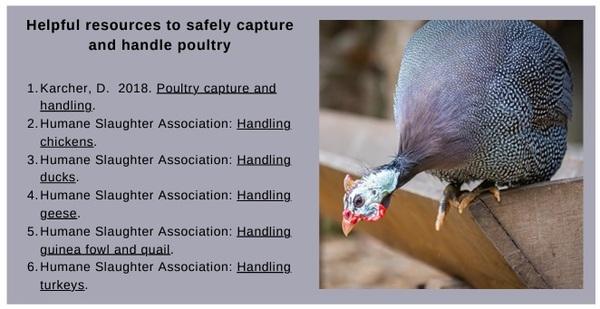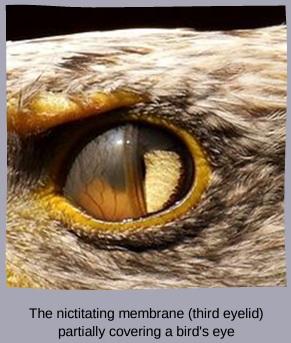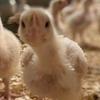On-farm euthanasia is not a pleasant topic, but when raising poultry, there are often circumstances that require birds to be euthanized, such as illness, injury and disease, because it is not always possible or feasible to treat affected birds.
Euthanasia refers to “good death” and is distinct from other terms such as culling and slaughter (defined below). This newsletter provides an overview of factors that should be considered before euthanizing poultry. The next newsletter will examine specific on-farm euthanasia methods for small numbers of poultry.
Definitions
Euthanasia: According to the American Veterinary Medical Association (AVMA), euthanasia refers to a “good death” and a humane way of ending an animal’s life; death that is as rapid, painless and as free of distress as possible and that reduces further suffering. For death to be humane, the method used should cause “rapid loss of consciousness, followed by cardiac or respiratory arrest and, ultimately, a loss of brain function”; animals should not regain consciousness.
Slaughter: Although slaughter also refers to ending the life of an animal, in an animal production context this term specifically refers to killing animals for the production of food or other products and typically involves a process whereby the animal is first rendered insensible (unconscious).
Culling: This term refers to reducing the number of animals or ending the life of some animals when those animals are not necessarily injured or ill. Animals should be properly euthanized during the culling process.
Mass depopulation: This term applies to situations where large numbers of animals are killed, usually to contain and prevent disease outbreaks, such as in the case of avian influenza.
Factors to consider
When considering on-farm euthanasia, there are several factors to take into account in addition to the specific method used. These considerations include the welfare of the bird; personnel safety, experience and training; costs and limitations of the method used; and aesthetics.
A. Bird welfare
In our previous newsletter, we discussed when to treat and when to euthanize animals. Onfarm euthanasia involves various actions and procedures, in addition to the application of the euthanasia method itself. These procedures include capturing, handling, restraining and ensuring that the bird does not regain sensibility (consciousness). The particular method that is used for on-farm euthanasia should minimize pain and distress to the bird, and catching and handling should be done in as stress-free a manner as possible. In many cases, birds that will be euthanized will already have other ailments that cause pain, such as lameness or injuries, and care must be taken to reduce further pain and injury.
Depending on their size and body weight, some birds are more challenging to capture and handle, which can contribute to both bird and personnel stress and risk of injury.
B. Personnel safety, experience and training
Personnel, producers, owners and employees have different levels of comfort with handling poultry, and euthanasia is no exception. To ensure that on-farm euthanasia is applied properly, all personnel need to be trained on how to appropriately capture, handle, and restrain poultry and apply the euthanasia method. In addition to these skills, personnel also need to be trained in how to identify signs of insensibility (consciousness) in poultry to ensure that euthanasia is effective and humane.
Signs of insensibility (unconsciousness)
Birds that have been appropriately euthanized should show the following:
- No vocalization
- No breathing; there should be no rhythmic movement of the chest, no air going into or out of the beak and no gasping
- No blinking; the eyes should not be blinking and there should be no movement of the nictitating membrane (third eyelid) if the outer eyelid is opened
- No pupil constriction; there should be no pupil constriction if a light is shone in the eyes (pupils should not decrease in size)
- No tension in the jaw and neck muscles; the neck and jaw should not be stiff when lifted
- No reaction if the toe or comb is pinched
If any of these signs are still present after the euthanasia method has been applied, the method should be applied again immediately or another method should be applied. Thereafter, the bird should be examined again to ensure that the bird is insensible.
C. Costs and limitations
All euthanasia methods require that personnel and flock owners are trained and skilled at identifying indicators of insensibility. However, some methods require more precision and training than others, and some methods also depend on the strength of the operator. Some methods, such as cervical dislocation and blunt force trauma do not cost much, whereas other methods such as gaseous methods and captive bolts require the purchase of supplies and equipment and regular maintenance. These factors all need to be considered when developing protocols for euthanasia of poultry, because euthanasia methods are only effective if they are used and properly applied. Personnel and flock owners should also be trained in performing a secondary euthanasia method in the even that the first method is unsuccessful. It is also important to note that various audit programs may require personnel or flock owners to demonstrate knowledge and skills related to euthanasia.
D. Aesthetics
Euthanasia is never pleasant, and some methods may be associated with involuntary muscle movements (convulsions) or blood loss. Personnel need to be trained and know what to expect when using a particular method to ensure that euthanasia is effective and applied when necessary.
Summary
- On-farm euthanasia requires a rapid and humane death
- All personnel need to be trained in proper handling, restraint, euthanasia techniques and how to recognize signs of insensibility
- Considerations for on-farm euthanasia include
- The method being used
- Animal welfare
- Personnel experience, training and safety
- Cost and limitations of the method used
- Aesthetics of the method used
- The next PEC newsletter will examine specific methods of poultry euthanasia




















